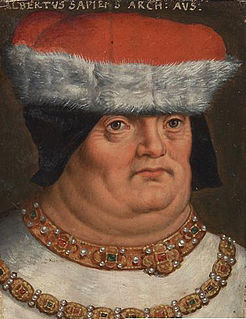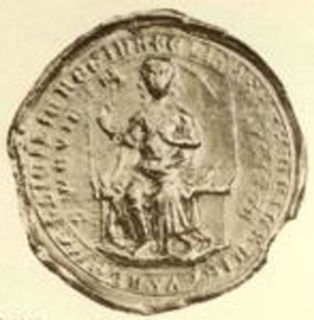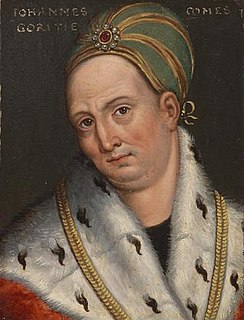Life
His parents were Count Albert II of Gorizia and Euphemia of Mätsch. From 1338 to 1365, he ruled Gorizia jointly with his brothers Albert III and Henry V, after inheriting the county from their uncle John Henry IV. From 1362 when Henry V of Gorizia died, he ruled alongside Albert III. From 1365, Meinhard VI ruled Gorizia alone. He failed in a claim over the County of Tyrol when his second cousin Margaret was forced to cede Tyrol to Rudolf IV, Duke of Austria, in 1363. This ended the "dominium Tyrolis" which had existed since 1254.
He managed to reduce the power of the Patriarchate of Aquileia, however, the Republic of Venice became the beneficiary of the Patriarchate, which led to sharp contrasts between the parties involved. Meinhard retreated from Gorizia Castle to Burg Bruck (Schloss Bruck) in Lienz.
Meinhard's reign marked the beginning of the decline of the County of Gorizia. The princes of Gorizia had to mortgage and sell more and more of their possessions to salvage their worsening financial position. Meinhard was involved in power struggles with his ecclesiastical neighbours, and in disputes with the Habsburg dynasty about the succession in the Duchy of Carinthia and the County of Tyrol.

The Duchy of Carinthia was a duchy located in southern Austria and parts of northern Slovenia. It was separated from the Duchy of Bavaria in 976, and was the first newly created Imperial State after the original German stem duchies.

Henry of Gorizia, a member of the House of Gorizia, was Duke of Carinthia and Landgrave of Carniola and Count of Tyrol from 1295 until his death, as well as King of Bohemia, Margrave of Moravia and titular King of Poland in 1306 and again from 1307 until 1310. After his death, the Habsburgs took over Carinthia and Carniola and held them almost without interruption until 1918.

Margaret, nicknamed Margarete Maultasch, was the last countess of Tyrol from the House of Gorizia (Meinhardiner), and an unsuccessful claimant to the Duchy of Carinthia. Upon her death, Tyrol became united with the Austrian hereditary lands of the Habsburg dynasty.

Albert II, known as the Wise or the Lame, a member of the House of Habsburg, was duke of Austria and Styria from 1330, as well as duke of Carinthia and margrave of Carniola from 1335 until his death.

Meinhard II, a member of the House of Gorizia (Meinhardiner), ruled the County of Gorizia and the County of Tyrol together with his younger brother Albert from 1258. In 1271 they divided their heritage and Meinhard became sole ruler of Tyrol. In 1286 he was enfeoffed with the Duchy of Carinthia and the adjacent March of Carniola.

Albert I, a member of the House of Gorizia, ruled the counties of Gorizia (Görz) and Tyrol from 1258, jointly with his elder brother Meinhard IV. In 1271, the brothers divided their heritage and Albert became sole ruler of the Gorizia estates until his death. His descendants, known collectively as the Albertine line, ruled the County of Gorizia until the extinction of the House in 1500.

Meinhard I, a member of the House of Gorizia (Meinhardiner), was Count of Gorizia from 1231 and Count of Tyrol from 1253 until his death.
Meinhard III, a member of the House of Wittelsbach, was duke of Upper Bavaria and count of Tyrol from 1361 until his death. He was the son of Duke Louis V of Bavaria with Countess Margaret of Tyrol and as such also the last descendant of the Tyrolean branch of the House of Gorizia.

Elisabeth of Carinthia, was a Duchess of Austria from 1282 and Queen of the Romans from 1298 until 1308, by marriage to King Albert I of Habsburg.

The (Princely) County of Tyrol was an estate of the Holy Roman Empire established about 1140. After 1253, it ws ruled by the House of Gorizia and from 1363 by the House of Habsburg. In 1804, the county of Tyrol, unified with the secularised prince-bishoprics of Trent and Brixen, became a crown land of the Austrian Empire. From 1867, it was a Cisleithanian crown land of Austria-Hungary.

The County of Gorizia, from 1365 Princely County of Gorizia, was a State of the Holy Roman Empire. Originally mediate Vogts of the Patriarchs of Aquileia, the Counts of Gorizia (Meinhardiner) ruled over several fiefs in the area of Lienz and in the Friuli region of northeastern Italy with their residence at Gorizia (Görz).

The Counts of Gorizia, also known as the Meinhardiner, were a comital and ducal dynasty in the Holy Roman Empire. Named after Gorizia Castle in Gorizia, they were originally "advocates" (Vogts) in the Patriarchate of Aquileia who ruled the County of Gorizia (Görz) from the early 12th century until the year 1500. Staunch supporters of the Emperors against the papacy, they reached the height of their power in the aftermath of the battle of Marchfeld between the 1280s and 1310s, when they controlled most of contemporary Slovenia, western and south-western Austria and north-eastern Italy. After 1335, they began a steady decline until their territories shrunk back to the original County of Gorizia by the mid 1370s. Their remaining lands were inherited by the Habsburg ruler Maximilian I.

Elisabeth of Bavaria, a member of the House of Wittelsbach, was Queen consort of Germany from 1246 to 1254 by her marriage to King Conrad IV of Germany.

The Counts of Ortenburg were a comital family in the mediaeval Duchy of Carinthia. Though they had roots in Bavarian nobility, an affiliation with the Imperial Counts of Ortenburg, a branch line of the Rhenish Franconian House of Sponheim, is not established.

Otto III, a member of the House of Gorizia, was Duke of Carinthia and Count of Tyrol from 1295 until his death. He ruled jointly with his younger brothers Louis and Henry VI.

Albert II, a member of the House of Gorizia, ruled as governor of the County of Gorizia from 1323, on behalf of his nephew Count John Henry IV. He inherited from his father only the lands in the Puster Valley.

Albert III, a member of the House of Gorizia, ruled as Count of Gorizia from 1338 until his death.

John Henry IV of Gorizia (1322–1338) was a medieval Count of Gorizia and a member of the Meinhardiner dynasty. He was the only surviving son of Henry III and his wife Beatrix of Lower Bavaria, the daughter of Duke Stephen I. He succeeded his father as Count of Gorizia in 1323. Because he was still a minor, his mother and his uncles Albert II of Gorizia and later Henry of Carinthia acted as regents. After 1329, the custody was taken over by his cousin Albert III. Since he died young, he never actually reigned himself. Nevertheless, in 1332, aged nine, he was elected as podesta of Trieste, in the city's attempt to forge an alliance with Gorizia against Venetian expansion.

Henry VI (1376–1454), a member of the House of Gorizia, ruled as Count of Gorizia from 1385 until his death. He was also Count Palatine of Carinthia, governor of Belluno-Feltre and Landeshauptmann of Carniola. Through his first marriage with Elizabeth of Cilli, he was the brother-in-law of Sigismund of Luxembourg, Holy Roman Emperor and King of Hungary.

John Meinhard VII, Count of Gorizia was a member of the Meinhardiner dynasty. He was a Count Palatine of Carinthia and a Count of Kirchberg.
















